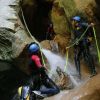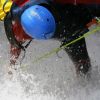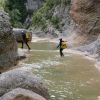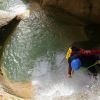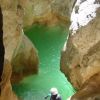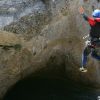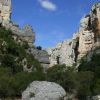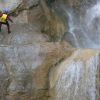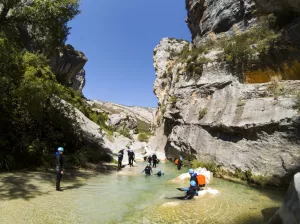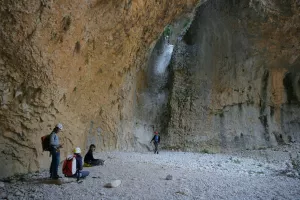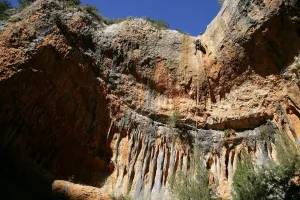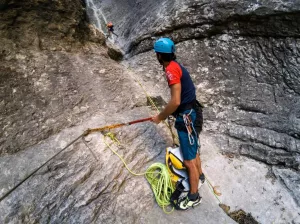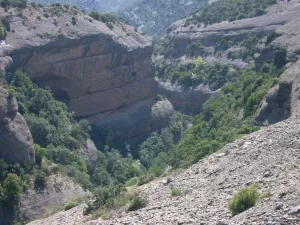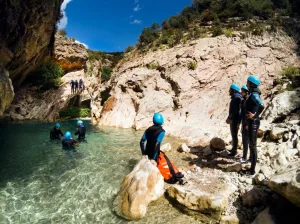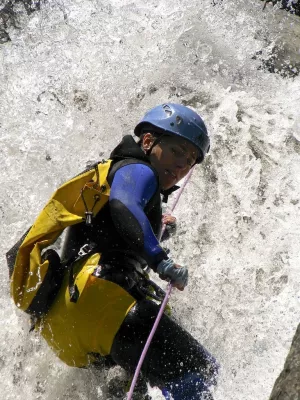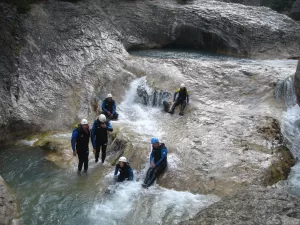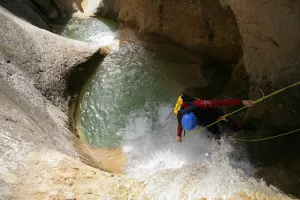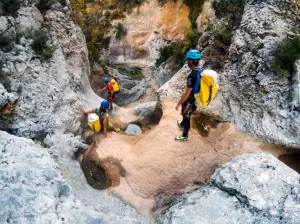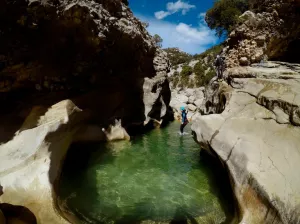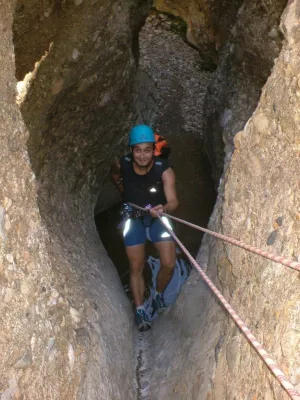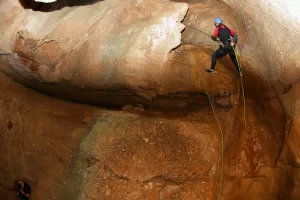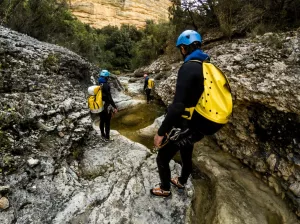The Mascún canyon is widely considered to be one of the most beautiful in Europe and is emblematic of the Sierra de Guara national park. It is strongly recommended that persons wishing to descend this canyon contract a professional and experienced guide due to the great physical exertion required and danger involved during periods of high water levels. A total of 9 hours are needed, meaning that only those in peak physical condition and with plenty of canyoning experience should attempt it.
Since canyoning became popular in the Guara region, the Mascún canyon has succeeded in stirring up great interest with those who visit. It is, without doubt, one of the most spectacular descents due to its sheer cliffs, which almost touch in places such as “El Puntarrón,” and its astonishing stone architecture. Although the flow of water dries up at certain times of the year to offer a different aspect, the descent with water offers a fantastic spectacle of light and colour. The canyon is also one of the most diverse in terms of its attractions; 9 rappels, numerous jumps, underground stretches etc. As if all this wasn’t enough, the descent boasts one of the most unusual and mythical landscapes of the area with famous landmarks such as la Ciudadela, the oak groves and uninhabited village of Otín and the Saltador de las Lañas.
Mascún offers a magnificent descent along a river bed chiselled from rock with deep pools of turquoise water, exciting rappels and technical jumps, all of which add up to an unforgettable experience.
Downloads
Technical information
Aproximación: 2h:45 min. Leave the car in Rodellar; from here it is a 3 hour walk to the start of the canyon. From Rodellar go down to the river bed along the well marked path, and once there, follow the river upstream for around 45 minutes. Here, a fork in the path branches off to the left and is signposted as Otín and Mascún. Then follows an arduous climb to reach the abandoned village of Otín; follow the path as it skirts the village and take the path towards the north. Arriving at a poplar grove indicates the entrance to the Raisen canyon; continue on until you reach a fork to the right (not very well signed) that goes to the entrance to the Mascún canyon. Nearest village: Rodellar
Descent: 3 - 4 hours KM: 8,3km
Retour: 2 - 3 horas
Escape routes:
- Saltadero as Lañas waterfall in the direction of Raisen
- Waterfalls of Peña Guara
- 100m before the “Oscuros” it is possible to cross a stony pit to leave the canyon; once in the Oscuros there are no escape routes.
- El Sendero d’o Turno is the best route out of the canyon
Car combination n/a
Difficulty level: very high in any season of the year
Minimum equipment requirements:
- Full wetsuit and neoprene socks or canyoning shoes.
- Neoprene gloves
- Helmet
- Harness
- Double anchor lanyard
- Ropes
- Equipment for abseiling (figure-of-eight descender)
- 2 ropes of at least 35m in length.
- Waterproof canyoning backpack
- Watertight barrel
- Picnic
Points of interest
- Oak Groves of Otín, with magnificent specimens
- The uninhabited village of Otín
- Cuca Bellostas. A towering rock spire, which is one of the most recognised landmarks in the area. Its name is phallic in origin and makes reference to a big headed villager from Otín of old.
- La Ciudadela and the natural rock architecture of the canyon. The extreme shapes and forms, such as obelisks, spires, gigantic monoliths, natural bridges, hollows and ledges, give the valley an aspect of an enchanted city in ruins. This landscape once intimidated walkers and villagers and was said to produce overpowering sensations in the depths of the gorge due to its marked silence and solitude. The name Mascún derives from a Moorish name meaning “a place inhabited by spirits.”
- Surgencia de Mascún. A famous and quite spectacular spring, which provides the gorge with a permanent supply of water.
- Saltadero' as Lañas. A temporary waterfall in the rocky hollow at the entrance to the canyon; it falls 30m over smooth, terraced rocks.
- Birdwatching. See vultures around La Ciudadela and Egyptian Vultures from the start of the canyon to the “caos.”
Photo gallery



